food system
the board game
André Boeing January 9th, 2024
Simplifying the complexity of food systems to 4 quadrants and designing an educational board game to learn about food systems.
As a beginner in the wide fields of food systems I was overwhelmed with the complexity of the different aspects and sub-systems last Monday: my first day in this new work topic as an educator or more precise in the context of food systems: a 1st year student.
I had to simplify the whole thing for myself to better locate where I want to explore the “World of Food Systems”in the huge, integrated systems of food circulation – a timeless, fundamental basis, that keeps us alive. Way back in time and into the Future.

4 quadrants, that one thumb can count on one hand touching each finger: One, where all the food grows. One, where it is being processed. One, where it is being cooked and eaten. And one, where all the waste goes:
Cultivating > Processing > Cook & Eat > Waste. A cycle.
The board and systems map
I was able to reduce the many aspects of food systems into 4 main quadrants and briefly tested if I could fit or squeeze every aspect into one of these 4 quadrants.
4 quadrants, that one thumb can count on one hand touching each finger: One, where all the food grows. One, where it is processed. One, where it is cooked and eaten. And one, where all the waste goes: Cultivating > Processing > Cook & Eat > Waste. A cycle repeating itself.
I am easy to catch with a more gameful, playful, mythic, colorful and engaging approach to a 4 quadrant model. A simple diagram chart doesn´t do that for me although it´s helpful in the later process. I need a narrative, a story, a game, a quest to get going and I know, many of the young people of many ages I work with feel the same.
So my work buddy Chatti Gippity in it´s version 4 and the painter Dall-E and I were hanging out to find a graphical style and fitting Illustrations. A Mandala and colorful, vivid, surreal hidden objects playfield. After many many prompts and even conflicts with my mates that drove me crazy, I finished the thing with classic, manual Photoshopping grateful for the helpful input of my AI work mates. On day 2 we had a finished board and map + a simplified model.
A quest card – fun tasks for the exploration of complexities
Next I had to get my self on a demo quest in one of those 4 quadrants and did a thing on Waste which is documented in this Journal entry:
Waste Land – beginning at the end
After the succesful quest I could reduce the steps into a demo quest card that we pick in the board game after an empty bottle rotating in the center of the board and stopping randomly in one of the 4 quadrants to indicate your quest type in the top left of each card.
On the way I´ve created a set of open source Photoshop PSD and AI generated grafix that can be easily shared under a Creative Commons Share alike for the creation of quest cards and printing out the board game at home, schools and educational places. This helps to rollout possible helpful solutions for the common good very fast.
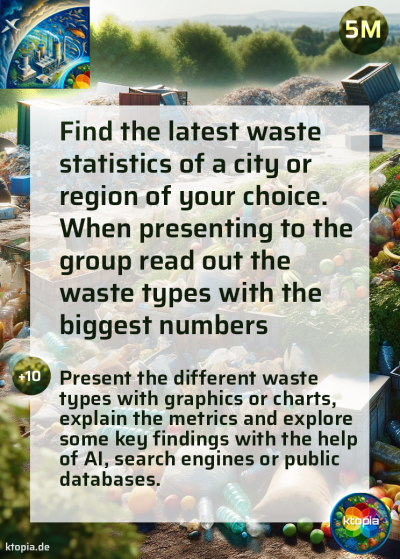
The cards have the standard size of common TCG ( Trade Card Games like Pokémon, Magic the Gathering, etc.) – so it is easy to buy some cool card sleeves for the printouts. 2.5 inches × 3.5 inches (6.3cm × 8.8cm)
A simplified 4 quadrant model for exploring food systems
Rotating clockwise from the top right quadrant. In the best case waste equals soil at 12 o’clock
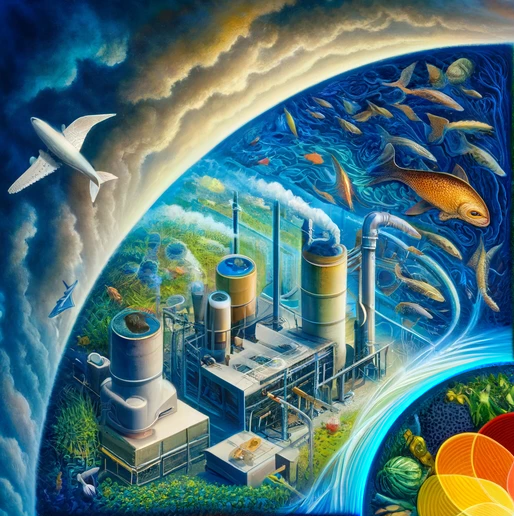
4 Waste
Our food systems create a variety of waste types with different kind of recyclabilities and decomposition times.
In Kassel we seperate or try to in hour house holds:
Residual Waste which can´t be recycled, light plastics for re-cycling, green compost, waste paper, empty, re-usable bottles, waste glas, batteries, electronics and bulk waste.
In the production of food products we have many more waste types from transportation, water pollution, etc.
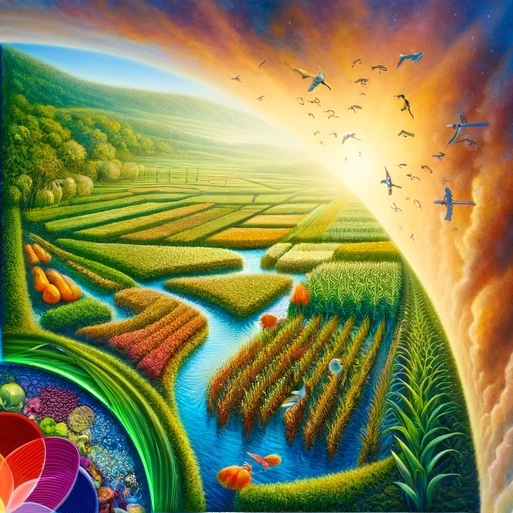
1 Cultivation
Cultivation in Biology is the creation and maintenance of conditions that ensure the growth of certain organisms.
Soil, Water, Seeds, Light. Agriculture, the land-based cultivation and breeding of plants (known as crops), fungi and domesticated animals. Horticulture, Permaculture, Aquaculture or Fungiculture. Large Scale Farming, community- or home gardening. To make it short: everything that creates and produces raw food ingredients.
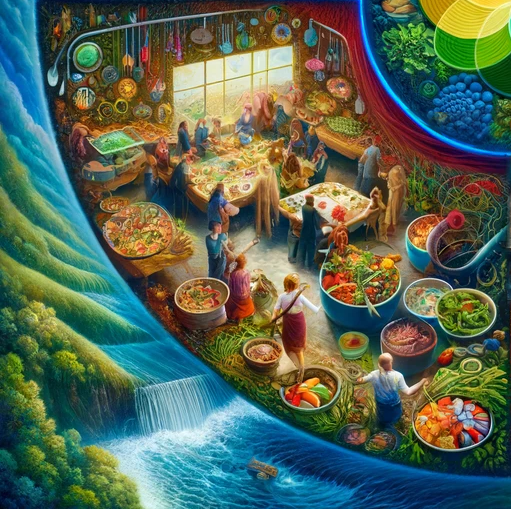
3 Cook+Eat
This part in food system theory is usually being called “consumption”. A not so pretty word for the holy acts of cooking and eating in my opinion.
At home, in gastronomy, delivery food, cantines, clinics, welfare places – people love to cook & eat – everywhere.
Cooking & Food is a whole culture of so many subcultures a highly social quadrant in food systems.
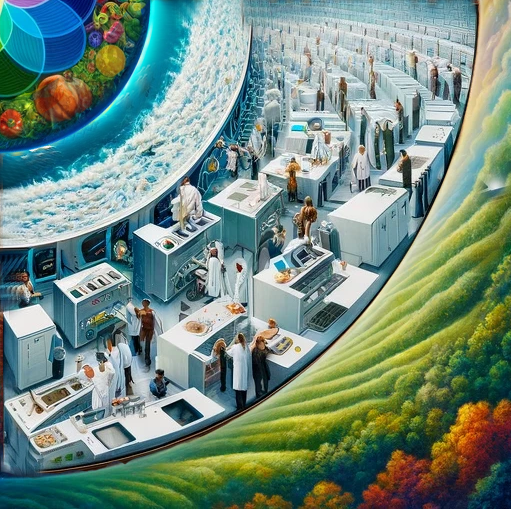
2 Processing
Transforming raw agricultural products into other forms, ingredients and mixed compositions.
Milling wheat into flour is a simple processing.
De-hydrating xx tons of tomatoes into a pulverized form, adding different kind of natural and artificial ingredients to have a fast sauce pulver ready to use in 2 minutes in Gastronomy is a more complex way of processing.

1 Cultivation
Cultivation in Biology is the creation and maintenance of conditions that ensure the growth of certain organisms.
Soil, Water, Seeds, Light. Agriculture, the land-based cultivation and breeding of plants (known as crops), fungi and domesticated animals. Horticulture, Permaculture, Aquaculture or Fungiculture. Large Scale Farming, community- or home gardening. To make it short: everything that creates and produces raw food ingredients.

2 Processing
Transforming raw agricultural products into other forms, ingredients and mixed compositions.
Milling wheat into flour is a simple processing.
De-hydrating xx tons of tomatoes into a pulverized form, adding different kind of natural and artificial ingredients to have a fast sauce pulver ready to use in 2 minutes in Gastronomy is a more complex way of processing.

3 Cook+Eat
This part in food system theory is usually being called “consumption”. A not so pretty word for the holy acts of cooking and eating in my opinion.
At home, in gastronomy, delivery food, cantines, clinics, welfare places – people love to cook & eat – everywhere.
Cooking & Food is a whole culture of so many subcultures a highly social quadrant in food systems.

4 Waste
Our food systems create a variety of waste types with different kind of recyclabilities and decomposition times.
In Kassel we seperate or try to in hour house holds:
Residual Waste which can´t be recycled, light plastics for re-cycling, green compost, waste paper, empty, re-usable bottles, waste glas, batteries, electronics and bulk waste.
In the production of food products we have many more waste types from transportation, water pollution, etc.
One, where all the food grows.
One, where it is being processed.
One, where it is being cooked and eaten.
and One, where all the waste goes:
Cultivating > Processing > Cook & Eat > Waste
A cycle…